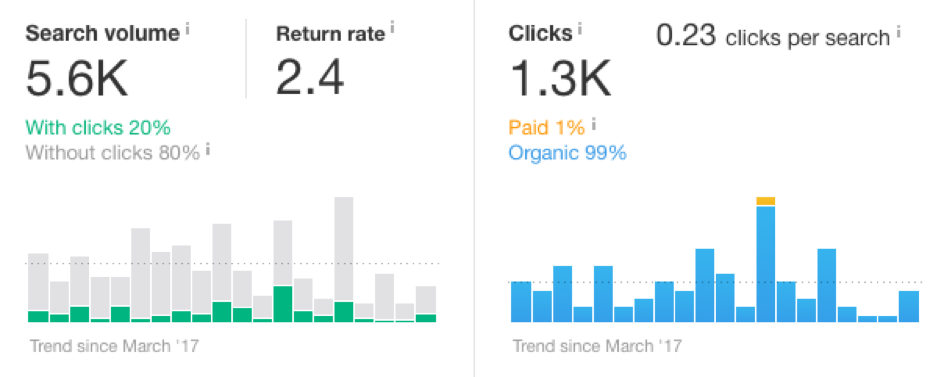As search marketers, we all want to own as much SERP real estate as possible, because it means more visibility and more traffic.
Trouble is, page one is steadily changing.
Organic search results are now competing for the user’s attention with paid ads, knowledge panels, maps, videos, featured snippets, and the like.
In this article, you will:
- Understand the challenge of competitive SERPs.
- Learn how to use On-SERP SEO effectively.
- Develop a “Traffic Potential” mindset.
- Get seven actionable tactics to boost your search presence right now.
Understand The Challenge Of Competitive SERPs
Search engine result pages (SERPs) are more competitive than ever.
We’re starting to see many different types of media elements ranking.
The decline of organic traffic for top-performing keywords is rooted in the presence of new elements on page one.
The organic position one is now often bumped low behind ads, maps, media elements, and featured snippets.
We, therefore, call these elements “position zero” because they outrank even the top organic results.
One of the most competitive versions of SERPs is zero-click searches.
A zero-click SERP is one where the answer is displayed directly on the search results page satisfying the search intent of the user without having to click further.
So, how can SEO professionals stay effective when the SERPs are becoming more competitive?
Use On-SERP SEO To Stay Competitive Against Position Zero SERPs
On-SERP SEO is the work of optimizing the entire first page.
The goal is to take up as much real estate on page one as possible, thus increasing CTR and generating more organic traffic.
On-SERP SEO requires a paradigm shift for SEO professionals.
It is an integrated strategy to increase search appearance and brand awareness on page one.
It is the SEO taking ownership of Google traffic, no matter which SERP elements it comes from.
To be competitive in the world of zero position SERPs, this means SEO pros must coordinate all kinds of different media sources to dominate every relevant aspect of page one.
The ‘Traffic Potential’ Mindset You Need To Succeed In SEO Today
When doing your keyword research, defining your target pages and selecting target search terms, there’s one important mindset shift to make to future-proof your SEO strategy:
Factor in the new SERP reality.
In traditional SEO analysis, you’re used to reviewing:
- Search terms.
- Monthly search volumes.
- Keyword difficulty.
Today, however, you must adapt your efforts to factor in:
- The presence of featured snippets.
- Other media elements.
- Decreased CTR for organic results.
Therefore, you must now include CTR in your keyword research and decision-making.
To do this, most SEO tools include a traffic potential factor you can use.
This is an example from Ahrefs for a classic no click, zero position search term: “time Berlin”:
 Screenshot from Ahrefs, June 2022
Screenshot from Ahrefs, June 2022Ahrefs shows us a significant search volume, however, we also see that 80% of all the searches never receive a click.
You should start basing your analyses on this click potential, rather than monthly search volume alone.
Only then will you receive the best CTR and true organic traffic gains for the content you create.
By reviewing the true click potential, you will filter for keywords where a good organic ranking still equates to viable search traffic opportunities.
7 Actionable Tactics To Optimize Your Website In Competitive SERPs
Now that we’ve altered your mindset, let’s discuss tactics to boost your search presence right now.
Within these tactics, we will cover how to take over different elements of the SERP, including an increased presence in organic search, paid ads, knowledge panels, and images.
1. Optimize Your Top 10 Ranking Keywords To Win A Featured Snippet
Optimizing to win featured snippets is not an exact science, but art in and of itself.
It seems to be the case that Google usually pulls data out of the current top 10 rankings to populate the featured snippet.
So, the first step is to check your current organic rankings and determine which of those keywords already displays a featured snippet (using tools like Ahrefs, Semrush, etc.).
Those will identify your target keywords and target pages to optimize for featured snippets.
The purpose of the featured snippet is to give a direct answer to the user without them having to click or search further.
There are four main types of featured snippets, depending on the query intent:
- Lists.
- Tables.
- Text.
- Video.
Your second step is to note what kind of featured snippet is displayed for each of your target keywords.
Featured snippets are usually displayed for long-tail queries and, more often than not, question queries.
To optimize for the featured snippet, add such questions or keyword terms as a subheadline to your content.
Immediately beneath the subheadline, create a precise answer.
This can be one paragraph (around 45 words on average), a list (ordered or unordered) or a table, depending on what Google favours for that keyword.
The more precise and factual you can get, the better.
Google likes pulling lists and data directly into the search results.
You can even use schema to markup lists and comparison tables.
2. Optimize For Google Sitelinks
Sitelinks increase the visual space of your search results by displaying the most important pages of your website directly within your search result.
Although you can’t force Google to display sitelinks, you can create a clear navigational structure – with strong internal links to the core pages, as well as anchors and alt tags that are descriptive – to increase your chances of Google displaying your sitelinks.
3. Add Schema Markup When Appropriate
Product, business, and review schema markup help Google to understand what your pages and content are about.
You can review the types of schema markup at schema.org and implement them on your pages.
The review schema markup can allow Google to display a star rating within your organic search results, which increases truth, credibility, and CTR.
4. Use & Optimize Google Business Profile
You can win a lot of space for local searches by verifying and optimizing your Google Business Profile.
This will also help your presence in Google Maps.
All features, amenities, and details of your business should be listed and displayed to make your Google Business Profile listing visually longer and provide important information.
Collecting reviews for the listing will also allow you to use it for the review schema markup mentioned above.
Bonus: Make sure to collect and answer questions on your listing! This will add valuable length to your listing.
5. Run Branded PPC Ads
Even if your heart belongs to SEO, organic search is your main traffic driver and pay-per-click (PPC) is super expensive in your niche, you should run ads on your branded terms.
Users searching for your brand name have the highest chance of converting from a search into a click.
Don’t ever let someone else occupy your valuable ad space.
A basic branded Google Ads campaign should always be running for your brand name terms.
Make sure to fill out all available fields and add relevant ad extensions for maximum visual impact.
Quick note: In certain niches, it might be beneficial to run shopping ads or hotel ads since they occupy prime real estate for transactional terms.
6. Optimize Your Knowledge Panel
The purpose of Google’s knowledge panels is to display all information about your business in one condensed spot.
They are available to display for companies, nonprofit organizations, influential people, local businesses, media (movies, TV, books, music), nutritional information, and products.
If your company falls into one of the above categories you stand to benefit greatly from optimizing your Knowledge panel.
7. Optimize Images To Appear In SERPs & Featured Snippets
It’s important to review your target keywords and see if images are included in their SERPs.
Why? Because a lot of SERPs feature images.
If so, proceed with some basic image SEO to increase the chances of your relevant images ranking.
Make sure to include such images on a page where the headline and URL match the image target keyword.
For your information, image SEO ranking factors include:
- The image file names and alt tags: Choose appropriate and keyword-optimized names.
- Image context: Place your image on a part of the website where the surrounding content matches the keyword intent.
- Image captions with short and relevant descriptions.
- Image sizes with common dimensions (e.g., 900 pixels wide and 16:9)
Following these seven tactics will allow you to achieve effective wins on page one that goes beyond position one rankings.
They’ll enhance your presence in competitive SERPs and increase your chances of getting that money-making click.
The Future Of SERPs & How To Win With On-SERP SEO
A key strength of SEO lies in your ability to analyze and play to the advantage of the full search result page.
On-SERP SEO is a perfect example of this.
By following the seven actionable tactics we’ve outlined, you can enjoy more SERP real estate – and that means more opportunities to capture searchers’ attention and increase brand awareness and click-through rates.
More Resources:
- Mastering SEO Within Google’s SERPs [Podcast]
- How To Dominate SERPs By Focusing On Topics Instead Of Keywords
- How Search Engines Work
Featured Image: Rawpixel.com/Shutterstock





![AI Overviews: We Reverse-Engineered Them So You Don't Have To [+ What You Need To Do Next]](https://www.searchenginejournal.com/wp-content/uploads/2025/04/sidebar1x-455.png)